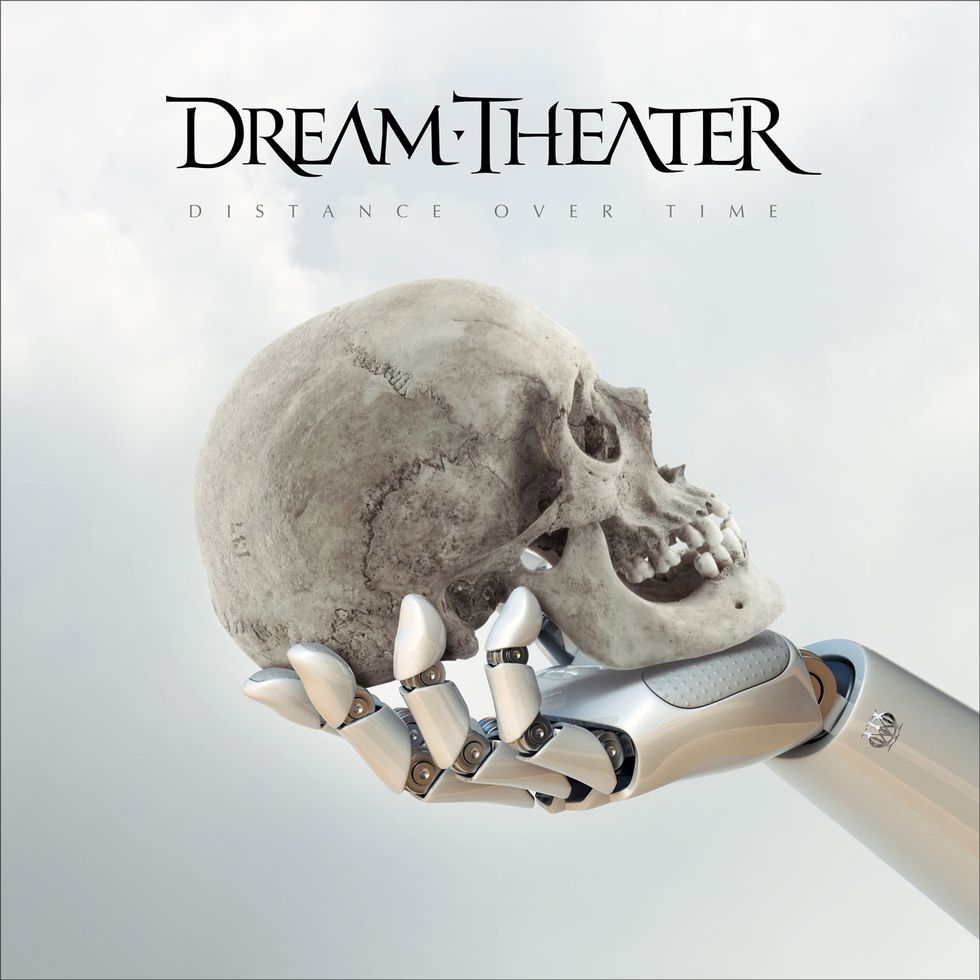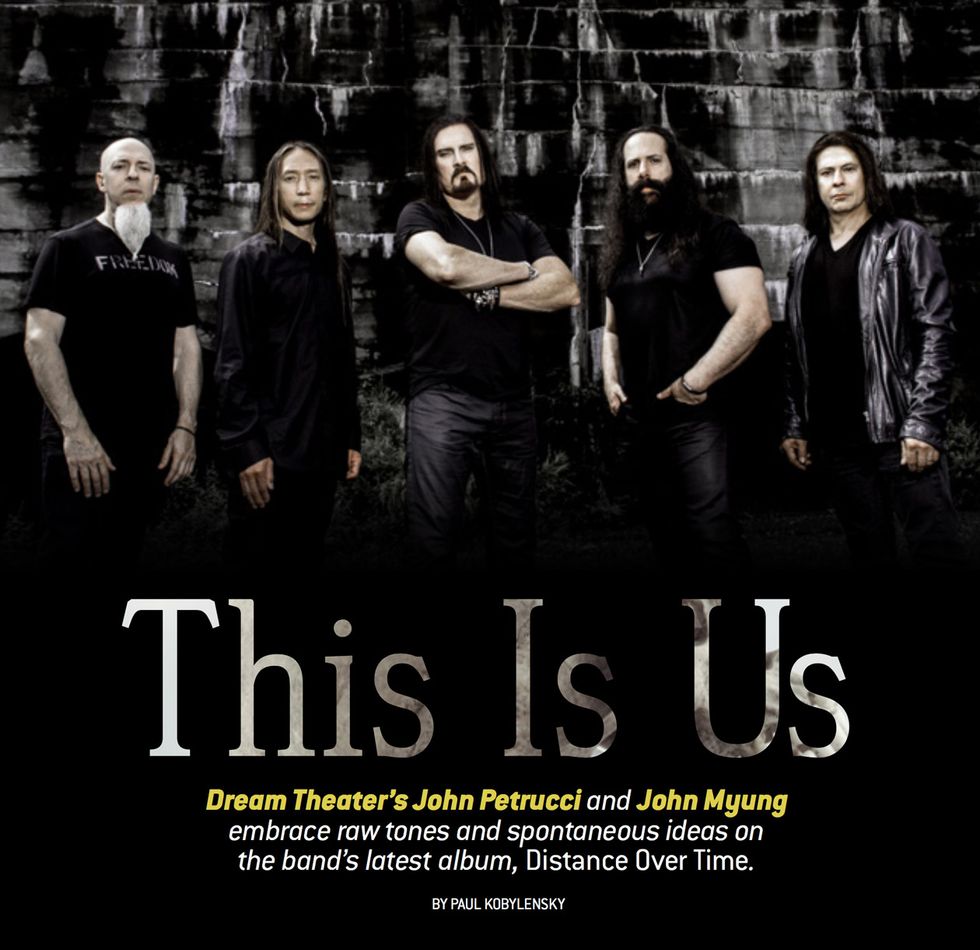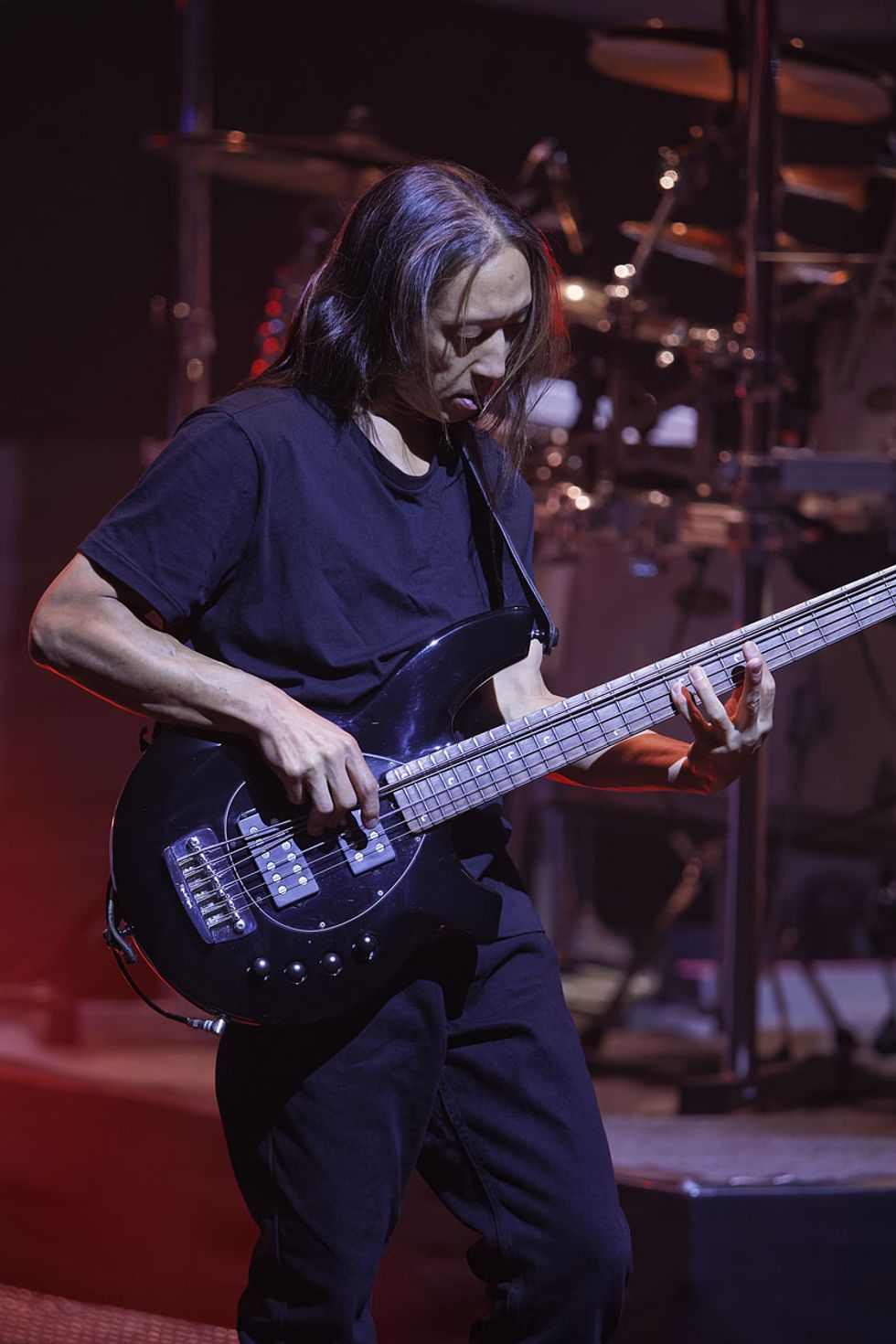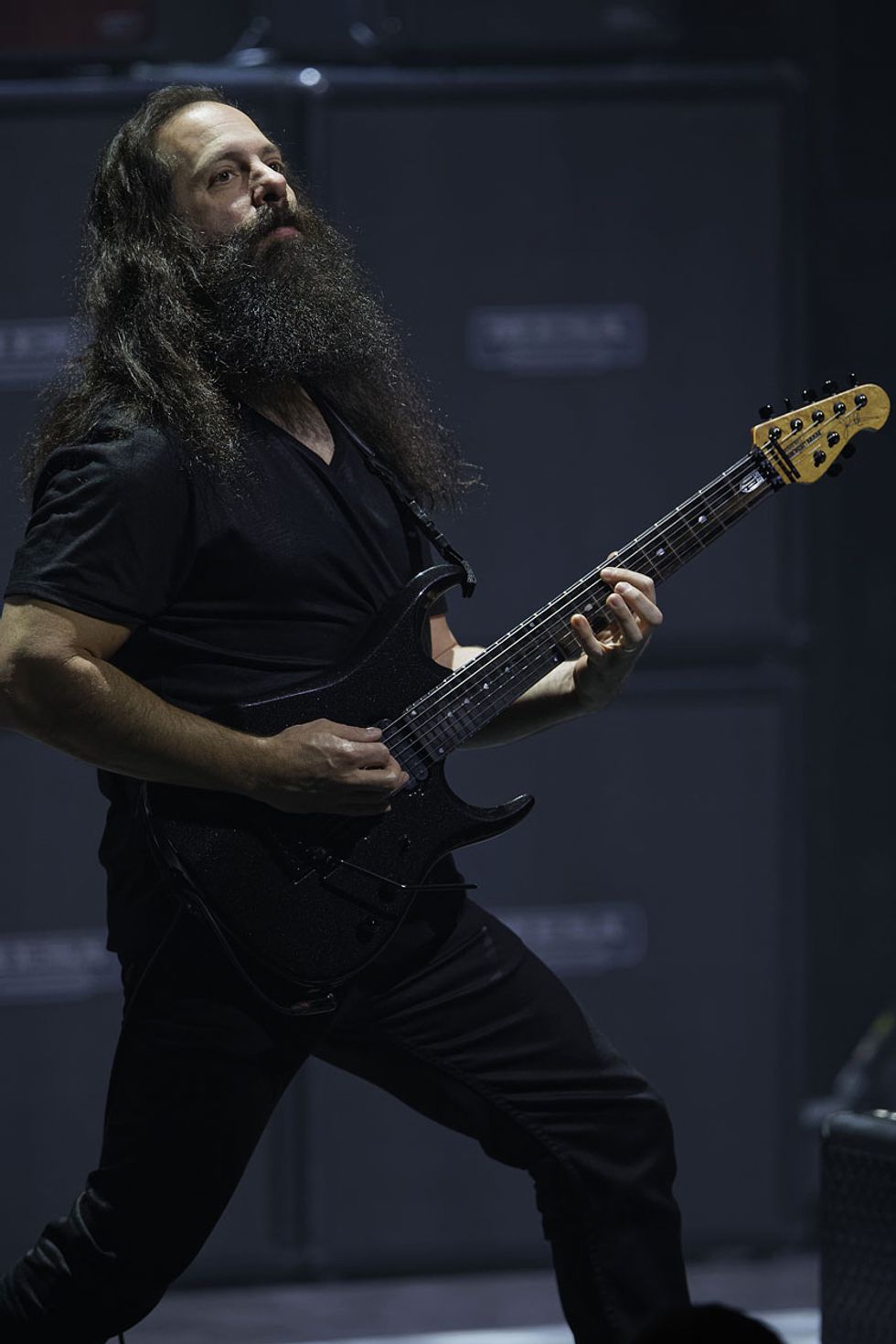The Astonishing, Dream Theater’s 2016 concept album, was a massive undertaking, even by their standards. Crafting the rock opera was a challenge: The band had to create the concept, write the story, compose and record the music, and track full orchestras and choirs. Then they had to find a way to present the spectacle on tour with full story line and video accompaniment. But masterfully helmed from the start by guitarist John Petrucci and keyboardist Jordan Rudess, the album and world tour were a magnificent success.
As if that weren’t enough, the band hit the road again to commemorate the anniversary of their 1992 breakthrough album, Images and Words. So how did Dream Theater finally come down from the creative whirlwind of the last few years? “My two eldest graduated from college and we took a much-needed family vacation,” says Petrucci. “But I also did two legs with G3 in the U.S. and Europe.”
When Dream Theater reconvened to record their latest album, Distance Over Time, each member knew it was time for a back-to-basics approach. Intent on relaxing and discovering what a stripped-back Dream Theater sounded like more than three decades after its inception, the band—which also consists of vocalist James LaBrie, bassist John Myung, and drummer Mike Mangini—found a beautiful but undisclosed location in upstate New York. The original plan was to enjoy communal time writing and connecting as the long-time friends they are. But fate had other plans.
As Myung recalls, “It was like, ‘Man, we don’t want to leave this place and go into Manhattan just to have the whole vibe change. Let’s just stay here.’ So that’s what we did. We recorded the whole album there.”
While you might assume a scenic getaway with great friends and a more laid-back approach might tame the band’s sound, one spin through the resulting offering reveals quite the opposite. By stripping away the layers of orchestrations, overdubs, and studio techniques that defined the last album, Distance Over Time emerges as what may be the most immediate and sonically direct album of Dream Theater’s lauded career.
Or as Petrucci succinctly puts it, “This is what Dream Theater sounds like.”
From the moment the opening track, “Untethered Angel,” confronts your eardrums, it’s clear what he means. While songs like “Room 137,” “Barstool Warrior,” and “Paralyzed” display the band’s trademark moves, it’s the album’s rawness, the clarity and character of Myung’s bass, and the power of Petrucci’s straightforward tones that truly elevate this effort.
Gearing up to embark on yet another relentless tour, Myung and Petrucci were happy to give Premier Guitar a peek behind the curtain that surrounds Distance Over Time. The conversation, like the synergistic nature of their playing, reveals a confident and inspired Dream Theater that’s more powerful and unified than ever.
Distance Over Time diverges quite a bit from The Astonishing, both sonically and artistically. What was different about the process this time?
John Petrucci: It was a completely different approach. The Astonishing was conceptual, story-driven. We had a ton of orchestration with an orchestra and choir. Jordan and I wrote it and everybody recorded it. So it was not as inclusive of an experience for the band. This time, it was quite the opposite. It was all of us together as a band writing, hanging out, coming up with all the ideas—everybody contributing equally and really being a part of it. It was a lot more organic.
What inspired that approach?
John Myung: I think we were just looking forward to spending time in an environment like in the early days. It was important to not be in a full-on studio environment, which can be a bit clinical. So, it was nice connecting without any of that pressure. We just connected on a different plane.
John [Petrucci], you’ve produced several of the last few albums, yet each has a distinct sonic quality. What’s the trick to getting such a fresh sound after playing and writing together for so long?
Petrucci: First of all, I don’t want to give too much importance to that. It’s just a title. We just make sure we stay on track and do what we talked about doing. With Distance Over Time, we said, “Let’s make an organic-sounding record. Let’s keep it heavy. Let’s have fun. Let’s keep it sounding like we’re playing live and capture the energy that we have as a band.” Inevitably, somebody needs to figure out what the best way is to do that. So, that’s my job. But there’s so much talent in the band that it happens very naturally.
Myung: It definitely needs a leader when you have five people.
How did you go about accomplishing that on the album?
Petrucci: We recorded live demos as we wrote. This is what the band sounds like when we play together. We wanted to capture that in a bottle. It’s not a million overdubs, it’s not additional strings, or anything. This is the closest to hearing what Dream Theater sounds like when it’s just five guys playing and singing.
Myung: The important part is making decisions as a band. It’s the chemistry. It’s five people and how they connect the ideas. That’s what yields really interesting songs, when we’re on that plane.

Guitarist John Petrucci produced the band’s 14th studio album, Distance Over Time. “It was all of us together as a band writing, hanging out, coming up with all the ideas—everybody contributing equally and really being a part of it,” he says.
Petrucci: John’s right. If the ideas are strong, and if the chemistry is working, and everybody is on the same page, then it’s undeniable.
Each musician in Dream Theater is such a monumental talent. When you write, do you write to the specific players or is the song the only focus? Are you conscious of what your fans are expecting?
Myung: All of the above. You don’t want to write something that alienates people who expect a certain thing from us. But you’re also not really concerned with all of that, because then you’ll never get anything done. It’s just basically, if it feels right. If it isn’t happening, then we’ll break it back open and start to work on it again.
Petrucci: Exactly. There’s definitely something to be said for being a band and knowing each other for as long as we have. Like in the case of “Untethered Angel,” John came in with a bass riff, and I said to him, “I’d love to hear that in a different tuning, maybe in a lower register. Let me just try that.” And it morphs into something different. There’s a lot of trust that goes back and forth.
Dream Theater has always put a large focus on composition and “the song.” How are you able to balance that with the pyrotechnics that fans demand?
Petrucci: The song is the most important thing, at the end of the day. If the song isn’t there—the meaning, the message, the melody, the drive, and the passion—if that’s weak, there’s no hiding it. It doesn’t matter how technically good you are. Maybe it’s this prog-metal technical presentation, but within that are all of the elements of songwriting we really pay close attention to. Without that, you really don’t have anything. Just a bunch of notes.
John Myung plays a custom Music Man Bongo 6-string bass. “It’s a 6-string on a 5-string neck,” he explains. “It’s the perfect comfort for my left hand in terms of feeling like I’m not struggling.” Photo by Ken Settle
Years ago, you were asked about how you continue to improve your craft. You said you enjoy writing things that are beyond your technique, which forces you to improve. Is that still something you do?
Petrucci: Absolutely. In fact, I did that on this record. I’m very scared to figure out what the hell I did! Something that’s wonderful about being in a studio is you can take the time to come up with stuff that’s pushing your level. For me, it has to stay interesting. I always have to think of different things that I didn’t do before. But from a technical perspective, it’s literally grabbing my guitar, transcribing what I did, and trying to remember what the fingering was or the technique I used. It really is the key to becoming better.
What’s an example of that on the new album?
Petrucci: There’s a bunch of stuff. I did a solo in the song “S2N,” where I don’t know what the hell I did. I had some crazy moments and some wacky stuff on “Pale Blue Dot” that’s just insane, precision and speed-wise. There are a lot of guitar solos in this album, which is fun for me. So those moments are all over the record.
John [Myung], how has this album pushed your playing?
Myung: In my case, it’s the tools. It’s the different basses that I’ve played over the years. And it’s the experimentations over the past 10 years with getting the 6-string [Music Man] Bongo to a point where I’m really happy with it. It’s about evolving as a player, but also being able to evolve because I feel that my instrument is getting better.
There’s always been a real musical connection with Music Man basses and my playing, because I have a very heavy and percussive attack. I come from a school of players like Geddy Lee and Steve Harris, and that noise element is part of the sound. Of all the basses I’ve played, it’s only the Music Man that gave my style justice.
What’s different about your Music Man Bongos than stock versions?
Myung: It’s a 6-string on a 5-string neck. It seems like it’s the perfect comfort for my left hand in terms of feeling like I’m not struggling. That was a breakthrough: being a 6-string player and being able to have something I could grasp and that actually felt comfortable. And that also translates into the musicality of it. If I’m more comfortable behind it, everything just flows better.
You’ve been working on that instrument for a long time. Are we ever going to see a Music Man John Myung signature model?
Myung: You know, I’ve frequently been asked that over the years, and I can actually say we’re all working on something. So the answer to that question is, yes.
I rarely hear bass so clear and so full of character on heavy records. Aside from the bass, how did you go about getting that sound?
Myung: Well, our engineer Jimmy T (James Meslin) is probably a big reason for that. Working with a new engineer on this record, I was willing to break from the traditional recording gear that I have. One of the things we used was called the Neve Shelford Channel.

Guitars
Custom Ernie Ball Music Man 6-string Bongo with 5-string neck
Amps
Ashdown ABM-1200 head
Neve Shelford Channel (for direct recording)
Effects
None
Strings and Picks
Ernie Ball Slinky Cobalt 5-string set (.045–.130) with added .032 for high-C string
That was the main sound, in terms of getting a really pure tone. And then for amp tones, we just miked up an Ashdown—the ABM series. And that sounded great too. It just gave us what we wanted to hear without having to mess around with the knobs. So, it’s really just those two things: the Neve and the Ashdown. It really made a difference in this album.
Did you get the grind right from the amp?
Myung: Yeah. But the grind is also attack-driven. It’s how much energy is being created from the hand. It had that breadth of dynamic, where you can really lay in to it. You can play hard and it fattens up in the low end and it pushes and grinds. And if you back off, it cleans up and gets more subtle. So that’s the magic. There was a sense of space as the sound is moving rather than being non-responsive. I can’t deal with a non-responsive bass sound.
Petrucci: If I can say, this is an amazing bass record. Really. For bass players, you can really hear what he’s doing. He just kills it. And that goes back to that producer hat thing. We really wanted the bass to have a voice. It was, “Let’s make sure we get the best bass sound we can when we’re tracking. Let’s make sure when it’s being mixed that we let [mix engineer] Ben Grosse know we want the bass to be featured.” When the bass is out front like that, it’s amazing. Something like “S2N,” “Pale Blue Dot,” even “Untethered Angel” … what he’s playing on bass just sounds so cool. And it’s really exposed in a nice way. In fact, I didn’t record any rhythm guitar tracks when it’s a guitar solo, so it just sounds like it would if we’re playing live. If I go to play a solo, a lot of the orchestration is just bass, drums, and piano.
A great example of that is “Untethered Angel.” You and Jordan are playing harmonized lines, and it opens up and lets the bass breathe so much. It also elevates the lines you and Jordan are playing.
Petrucci: It doesn’t get more naked than that! There’s a drum groove, John is doing a Steve Harris thing, and the guitar and keyboard are left and right and very dry. You hear everything so clear. And that’s what I’ve been getting at with the whole direction of this record. We want people to hear what Dream Theater sounds like when we play. This is us.
That’s apparent as soon as you put on the album. It really highlights your individual performances and tones.
Petrucci: But how do you get that? You just record everything pure. You don’t add anything. It’s just John’s bass. There’s no extra stuff going on. It’s just my guitar plugged into my amp. It’s just Jordan playing the organ. That’s how you get it.
“Maybe it’s this prog-metal technical presentation,” says John Petrucci of Dream Theater’s music, “but within that are all of the elements of songwriting we really pay close attention to. Without that, you really don’t have anything. Just a bunch of notes.” Photo by Ken Settle
Dream Theater is known for its relationships with instrument manufacturers. So is it safe to assume that the album was tracked with your Music Man signature guitars and Mesa Boogie JP-2C amps?
Petrucci: Yes. This whole record was my Mesa/Boogie signature. It’s a dream come true for me. The Mark IIC+ was the holy grail Boogie that came out in the ’80s. It’s on Master of Puppets and everything. Then, finally, I convinced them to do a reissue and we made it into my signature head. So not only is it a bona fide reissue, but we modernized it as well. So, it does everything it could possibly need to do.
My guitars on the record are mostly the Majesty plugged straight into my JP-2C. And that’s it. If I plugged my guitar into that amp, cranked it, and we looked at each other, like, “Holy shit, that tone is unbelievable,” then it’s the engineer’s job to capture it. Put a mic on it and make it sound like that coming out of the monitors. And for the first time, we added a little bit of room mic.
You said you that you mostly used the Majesty. Were there any other guitars that you leaned on for specific parts?
Petrucci: Yeah. There’s the Majesty 6-string and 7-string on the album. And for two songs— “Paralyzed” and the one ballad on the album, “Out of Reach,” it’s the baritone tuned to Bb.
In the past, you’ve relied on a 1x12 cabinet for a super-tight sound in the studio. Was that the approach you took on this album?
Petrucci: For this one, we all brought all of our live touring gear. I had my two Boogie Recto 4x12s cranking. Ask John, it was really loud. [Laughs.] We literally said, “All right, just mike this.” That’s the sound.
And then I use my signature Dunlop wah. I’m biased, but the best one they’ve ever made is my JP95. And obviously, I’ve had the relationship with TC Electronic for a long time and I used my signature Dreamscape pedal. Another cool thing we used a lot is TC’s 2290-DT plug-in with the desktop controller. The 2290 was always a staple in all of my rigs, all my big refrigerator racks. And the plug-ins really sound true and authentic. So we ended up getting Ben Grosse one, and he used it on the mix. Whenever you hear a chorus and a guitar, that’s what it is.

Guitars
Ernie Ball Music Man Majesty
Ernie Ball Music Man Majesty 7-string
Ernie Ball Music Man Majesty Baritone BFR
Taylor V-Class acoustic
Custom Gypsy-jazz acoustic
Amps
Mesa/Boogie JP-2C 60/100-watt head
Mesa/Boogie Rectifier 4x12 with Celestion Vintage 30s
Effects
Dunlop JP95 Cry Baby wah
TC Electronic Dreamscape multi-effects pedal
TC Electronic TC2290-DT desktop-controlled plug-in
Strings and Picks
Dunlop Flow 2 mm
Ernie Ball RPS Slinky .010–.046 (6-string)
Ernie Ball RPS Slinky .010–.056 (7-string)
Acoustic guitar plays an unheralded role in Dream Theater, yet it has always been an important part of your sound. What acoustics do you track with?
Petrucci: I played a new Taylor acoustic they sent me with their new V-bracing system. And for the first time, on “Fall into the Light,” there’s an acoustic break that I doubled with a Gypsy-jazz guitar made by a German luthier.
Progressive rock, and especially progressive metal, rarely finds its way into the mainstream, yet it remains a vibrant scene. Why do you think that is?
Petrucci: That’s funny because it wasn’t always like that. When we started, the only band we’d get compared to was Rush. But fast forward, now there is a prog-metal scene. It’s adventurous. It’s fun. It’s challenging. There’s this sense of pushing yourself. And it’s a bit rebellious, as well. There’s a little bit of pride about being able to play a certain way and come up with wacky stuff that makes people smile and pull up their seats.
You listen to Animals as Leaders, and it’s like, “What the hell is he doing there?” And with my nephew, Jake [Bowen], and his band Periphery, it’s developing into a scene with a lot of different offshoots. Who knows how far it can go? People are just taking it in all different directions and there are no rules or limitations.
“Progressive” also serves as a great description of the Dream Theater legacy. Every album and every tour has been another step forward. So what’s left for Dream Theater to accomplish?
Myung: Well, I think the greatest thing about music is that it’s infinite. We’re all older now, and I think we’re at a point where the best stuff is yet to be written. It’s like the years of experience adds to the ability to create something more powerful. I think you enter a zone where it’s possible to write and do some of the best stuff that you’ve ever done. It’s a gift. It doesn’t feel exhausted in any way. I think the best is yet to come.
With everything you’ve accomplished, you guys are still looking up.
Petrucci: Yeah! It makes us smile every day. We love it.
Petrucci and Myung demonstrate their fretboard virtuosity while recording Distance Over Time’s lead-off single, “Untethered Angel.”














![Rig Rundown: Russian Circles’ Mike Sullivan [2025]](https://www.premierguitar.com/media-library/youtube.jpg?id=62303631&width=1245&height=700&quality=70&coordinates=0%2C0%2C0%2C0)












![Rig Rundown: AFI [2025]](https://www.premierguitar.com/media-library/youtube.jpg?id=62064741&width=1245&height=700&quality=70&coordinates=0%2C0%2C0%2C0)




















 Zach loves his Sovtek Mig 60 head, which he plays through a cab he built himself at a pipe-organ shop in Denver. Every glue joint is lined with thin leather for maximum air tightness, and it’s stocked with Celestion G12M Greenback speakers.
Zach loves his Sovtek Mig 60 head, which he plays through a cab he built himself at a pipe-organ shop in Denver. Every glue joint is lined with thin leather for maximum air tightness, and it’s stocked with Celestion G12M Greenback speakers.











